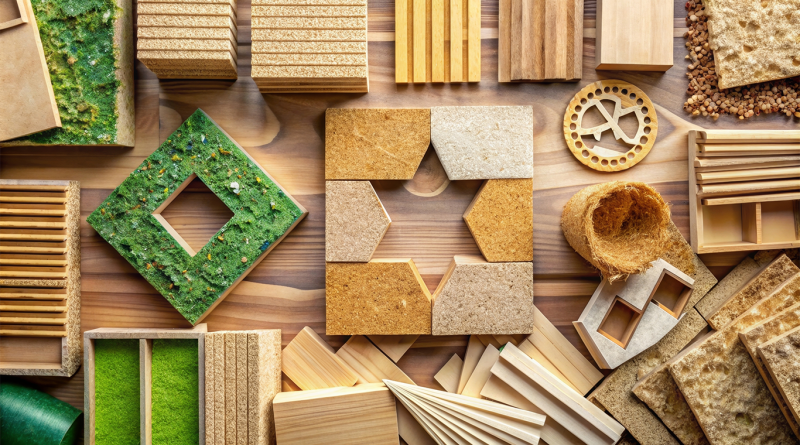Top 10 Sustainable Building Materials for Modern Homes
As the push for sustainability in home building gains momentum, selecting eco-friendly materials has become a top priority for modern homeowners and builders. Sustainable building materials not only reduce the environmental footprint but also enhance energy efficiency, durability, and health. Here’s a comprehensive look at some of the top sustainable building materials that are reshaping the future of home construction.
1. Bamboo
Bamboo is a rapidly renewable resource that grows much faster than traditional timber. It’s incredibly strong and versatile, suitable for flooring, cabinetry, and structural elements.
Benefits:
Rapid growth: Bamboo can be harvested in 3-5 years, making it one of the fastest-growing plants on Earth.
Strength: Comparable to steel in tensile strength, making it ideal for structural applications.
Carbon sequestration: Absorbs more CO2 than trees, helping to mitigate climate change.
Versatility: Can be used for a variety of applications, from flooring and paneling to scaffolding and furniture.
2. Recycled Steel
Recycled steel is a prime example of how waste materials can be repurposed for robust construction purposes. It is used in framing and structural support due to its durability and recyclability.
Benefits:
Durability: Resistant to pests, fire, and extreme weather conditions, ensuring longevity.
Recyclability: Can be recycled indefinitely without losing its properties, reducing the need for virgin materials.
Energy efficient: Requires 75% less energy to produce compared to new steel.
Sustainability: Using recycled steel significantly reduces mining and ecological damage.
3. Rammed Earth
Rammed earth is a natural building material that has been used for centuries. It involves compacting a mixture of earth, sand, and clay into molds to create strong, sustainable walls.
Benefits:
Thermal mass: Excellent at regulating indoor temperatures, reducing heating and cooling needs.
Non-toxic: Free from harmful chemicals and additives, promoting indoor air quality.
Aesthetic: Offers a natural, earthy look that can be both rustic and modern.
Longevity: Extremely durable, with structures lasting for centuries.
4. Hempcrete
Hempcrete is a composite material made from the inner fibers of the hemp plant mixed with lime. It’s lightweight, durable, and offers excellent insulation properties.
Benefits:
Insulation: High thermal and acoustic insulation, reducing energy consumption for heating and cooling.
Sustainable: Hemp grows quickly, often in less than four months, and is biodegradable.
Health benefits: Regulates humidity and has natural pest-resistant properties, contributing to healthier living environments.
Carbon negative: Absorbs more CO2 than it emits during production.
5. Cork
Cork is harvested from the bark of cork oak trees without harming them, making it a renewable and sustainable material. It’s used for flooring, wall coverings, and insulation.
Benefits:
Renewable: Cork trees can be harvested every 9-12 years without damaging the tree.
Insulation: Excellent thermal and acoustic insulation, enhancing energy efficiency.
Durable: Resistant to moisture, fire, pests, and rot.
Comfort: Soft underfoot and provides a warm, natural aesthetic.
6. Reclaimed Wood
Using reclaimed wood from old buildings and furniture reduces the demand for new timber and preserves historical character.
Benefits:
Environmental impact: Reduces deforestation and the demand for new wood.
Unique aesthetic: Adds character with its aged appearance and unique patina.
Durability: Often stronger than new wood due to its age and seasoning.
Sustainable sourcing: Utilizes materials that would otherwise end up in landfills.
7. Recycled Plastic
Recycled plastic is increasingly being used to create building blocks, insulation, and other construction materials. It’s an innovative way to reduce plastic waste.
Benefits:
Waste reduction: Utilizes plastic waste, reducing the amount of plastic in landfills and oceans.
Durability: Resistant to weather, pests, and moisture, ensuring a long lifespan.
Versatility: Can be molded into various shapes and sizes, suitable for a wide range of applications.
Low maintenance: Requires minimal upkeep compared to traditional materials.
8. Straw Bales
Straw bales are an ancient building material that provides excellent insulation and is highly sustainable. They are used as non-load-bearing infill in timber frame structures.
Benefits:
Insulation: High R-value, providing excellent thermal performance and energy savings.
Renewable: Straw is a byproduct of grain farming, making it a readily available and renewable resource.
Cost-effective: Generally cheaper than conventional insulation materials.
Eco-friendly: Reduces agricultural waste and promotes sustainable farming practices.
9. Ferrock
Ferrock is a carbon-negative concrete alternative made from steel dust and other recycled materials. It’s a relatively new material but shows great promise for sustainable construction.
Benefits:
Carbon sequestration: Absorbs CO2 during its curing process, making it carbon-negative.
Strength: Stronger and more flexible than traditional concrete, reducing the risk of cracking.
Waste reduction: Utilizes industrial waste materials, diverting them from landfills.
Durability: Resistant to corrosion and weathering, extending the lifespan of structures.
10. Mycelium
Mycelium, the root structure of fungi, can be grown into lightweight, biodegradable bricks. It’s an innovative and futuristic building material.
Benefits:
Biodegradable: Completely compostable at the end of its life cycle, leaving no waste.
Low energy production: Grows using organic waste and little energy, reducing environmental impact.
Fire-resistant: Naturally resistant to fire, enhancing building safety.
Versatility: Can be molded into various shapes and used for insulation, paneling, and bricks.
Incorporating sustainable building materials into modern homes is not just a trend but a necessity for the future. These materials offer various benefits, from environmental sustainability to enhanced building performance and occupant health. As technology and innovation continue to evolve, the range and efficiency of sustainable building materials will only improve, paving the way for greener, more resilient homes.
